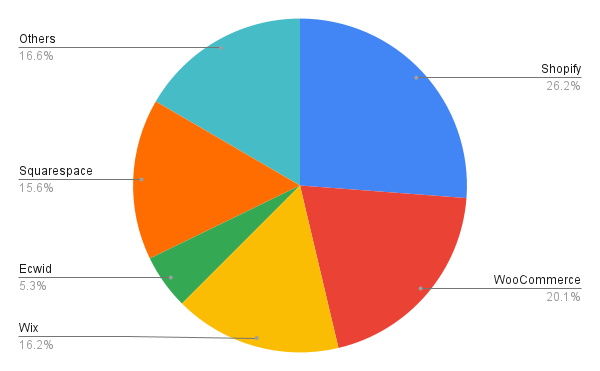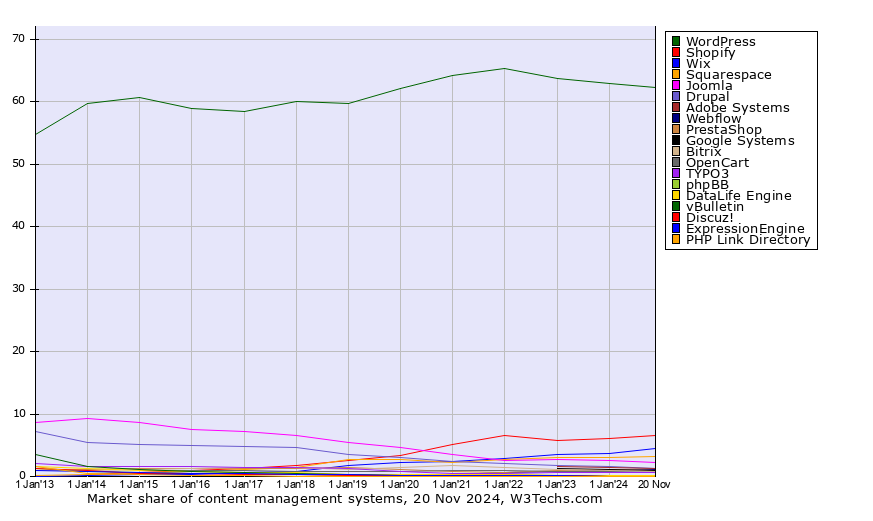CMS Market Share 2025 – Latest Trends and Usage Statistics

The digital age has democratized website creation. Thanks to Content Management Systems (CMS), millions are building online platforms without writing a single line of code to foster remarkable accessibility and collaboration.
But with countless CMS options available, which ones truly dominate the web? This blog will explore the CMS market share statistics for 2024 to find out which platforms are leading the charge and the trends shaping the industry.
Let’s dive right in!
What is a CMS?
Content Management Systems (CMS) offer a user-friendly way to create, manage, and publish content on the internet. These platforms have extensive libraries of pre-designed templates, add-ons, and external tools to help their users manage content without technical expertise.
Quick CMS Market Share Stats from August 2024
The CMS landscape is in constant flux. We must look at the bigger picture to understand the digital ecosystem. Here are some quick statistics to show the top CMS platforms, emerging trends, and the factors driving market share.
- 68.7% of all websites use a CMS (Themeisle, 2024)
- With a usage share of 62.7%, WordPress holds the vast majority of the CMS market. Shopify comes second with 6.2% and Wix is in third place with 3.8%.
- WordPress dominates content management platforms, holding 47.3% of the market, while Drupal follows with a 4.7% share, out of the top 1,000 sites ranked by traffic.
- Wix currently leads as the fastest-growing CMS, with an impressive 800% market share increase from 2016 to 2023.
Popular CMS Platforms by Market Share
As of August 2024, there are more than 78 million live websites (BuildWith, 2024), with the vast majority powered by content management systems. WordPress dominates the CMS market with a 62.7% market share, making it significantly more popular than any other platform.
The only other CMS with a market share exceeding 5% is Shopify. Following Shopify, Wix, Squarespace, and Joomla round out the top five, with market shares between 2.4% and 3.9% respectively.
Here’s a breakdown of the top five content management systems globally –
- WordPress: 62.7% market share
- Shopify: 6.4% market share
- Wix: 3.9% market share
- Squarespace: 3.0% market share
- Joomla: 2.4% market share

The data mentioned above includes only websites that have a CMS installed. However, there are millions of other websites that don’t use a CMS, instead they rely on hard-coded HTML or other web technologies.
If we include websites without CMS, WordPress holds a 43.3% market share (MobiLoud, 2024), compared to 31% of websites that do not use a content management system.
WordPress Market Share

- WordPress has the largest CMS market share with 62.7% (WPZoom, 2024).
- There are an estimated 38,000,000 live WordPress websites (AISEO, 2024).
- Nearly 4 million of these WordPress sites are based in the US, specifically in North America.
- WordPress’s CMS market share increased from 55.3% in 2011 to 63.1% in 2023, reflecting a growth of 7.8% (TechReport, 2023)
- WordPress is the most widely used content management system globally and is expected to maintain its leading position.
The data indicates a steady decline in hand-coded websites since 2011, while the number of WordPress sites has consistently risen each year. This trend suggests that WordPress is a favored choice for new CMS users.
This is understandable given that WordPress is known for its user-friendliness. It also offers high flexibility and customization options and can be downloaded for free from WordPress.org.
Websites built with WordPress vary widely, from simple sites with a few pages to complex eCommerce platforms, news outlets, and business sites. Notable examples include high-profile sites such as Microsoft News, TechCrunch, and TIME.
Wix Market Share

- Approximately 4.0% of websites using a known CMS are powered by Wix (W3Tech, 2024)
- Wix is used by 8.2 million live websites globally (Colorlib, 2024)
- Wix only represents 2.8% of all websites that do not use a CMS.
- Currently, Wix is the fastest-growing CMS platform, with a 149% annual growth rate (TechReport, 2024)
Of the top 1 million websites, 29.13% are built with WordPress, while only 0.82% use Wix. This indicates that Wix is more commonly chosen by smaller sites and businesses with lower traffic, rather than by high-traffic websites.
When comparing the two platforms, high-traffic websites are much more likely to be built with WordPress compared to Wix. Wix is also a paid CMS, with plans ranging from $4.50 to $35 per month.
Shopify Market Share

- Shopify’s market share in the CMS market grew from 3.4% in 2020 to 6.4% in 2024.
- Currently, there are more than 4.8 million live Shopify websites (MobiLoud, 2024).
- Shopify’s subscription revenue grew by 53% year-over-year in 2020.
- In Q1 2024, Shopify’s total revenue increased by 23% to $1.9 billion compared to 2023 (Shopify, 2024).
Shopify experienced a significant rise in popularity between 2020 and 2022, with its market share increasing by 3.4% over these two years.
This surge is widely attributed to the COVID-19 pandemic, which forced many physical stores to close and pushed businesses to find convenient online sales solutions. Similar to WordPress, Shopify offers a wide array of third-party apps, plugins, and themes that enable users to create powerful websites.
| CMS | % Market Share | No. of Websites |
| WordPress | 62.7 | 38 million |
| Wix | 3.9 | 8.2 million |
| Shopify | 6.4 | 4.8 million |
CMS Usage Statistics
- In 2011, approximately 76% of all websites were hand-coded. By 2022, this percentage decreased to around 33%.
- Today, more than 76 million websites use a content management system (CMS).
- Among the top 1 million websites by traffic, over 790 thousand are powered by a CMS (W3Techs, 2024).
- WordPress is used by 43.3% of all websites, representing a 62.8% share of the CMS market.
Market Value of Popular Content Management Systems
Aside from WordPress, other widely used content management systems include Shopify, Wix, Squarespace, Joomla, Drupal, Adobe Systems, PrestaShop, Google Systems, and Webflow.
Here’s a chart to show you the exact market share of each system –

Source: W3Techs
CMS Market Share History
WordPress has expanded its market share from 58.8% in 2016 to 63.7% in 2023, maintaining its position as the most widely used content management system by a significant margin.
Shopify experienced significant growth, increasing its CMS market share from 1.0% in 2016 to 5.7% in 2023, making it the second most popular content management system (W3Techs, 2024). This growth allowed Shopify to surpass both Joomla and Drupal, which held larger market shares in 2016—7.5% and 4.9%, respectively.
Below is an overview of CMS market share trends since 2016 –
Source: Themeisle
CMS Market Value
- The global CMS market was estimated to be valued at about $35.9 billion in 2018.
- By 2021, the market’s value was approximately $17.5 billion.
- The CMS market is anticipated to generate revenue of $22.10 billion in 2024 (Statista, 2024).
- With an expected compound annual growth rate (CAGR) of 4.91% from 2024 to 2029, the market is projected to reach a total value of $28.09 billion by 2029.
And with 68.7% of all websites using a content management system, it’s clear why this has become a billion-dollar industry, with no indication of slowing down.
CMS Forecast for 2024 and Beyond
The CMS market is poised for continued growth and evolution in 2024 and beyond. We expect a deeper integration of AI and machine learning to streamline content creation, personalization, and SEO.
Headless CMS will likely gain traction as businesses look for better flexibility and scalability. There’s also a growing emphasis on digital experience platforms (DXPs), which suggests a convergence of CMS capabilities with other marketing technologies.
Moreover, low-code and no-code CMS options will expand to empower a wider range of users to build and manage websites; as hand-coded websites have witnessed a steady decline (33%) from 2011 to 2022.
As a result, the CMS market is assured of significant transformation, offering both challenges and opportunities for businesses and developers alike.
Wrapping Up
The CMS market remains ever-dynamic, with WordPress solidifying its dominance while other platforms carve out their niches. Whether you’re a website owner or a developer, understanding the CMS market share can help you make informed decisions about which platform best suits your needs.
As the digital world continues to expand, the role of CMS in shaping online experiences will only grow in importance as well.
Frequently Asked Questions (FAQs)
Q. What is the largest CMS market share?
WordPress has the biggest CMS market share. Out of all the websites that use a known CMS, 47.3% of those sites use WordPress, as of 2024.
Q. What is the market size of CMS?
The CMS market is anticipated to generate revenue of $22.10 billion in 2024.
Q. Why is CMS popular?
CMS is popular because it simplifies website creation and management. Users without coding knowledge can easily build and update websites, while developers can use them to manage their projects effectively.
Q. What is the fastest-growing CMS?
Wix currently leads as the fastest-growing CMS, with an impressive 800% market share increase from 2016 to 2023.
Subscribe to Our Newsletter
Get the latest WordPress tutorials, trends, and resources right in your inbox. No Spamming, Unsubscribe Anytime.

Thank you for subscribing to our newsletter!
Table of Content
- What is a CMS?
- Quick CMS Market Share Stats from August 2024
- Popular CMS Platforms by Market Share
- WordPress Market Share
- Wix Market Share
- Shopify Market Share
- CMS Usage Statistics
- Market Value of Popular Content Management Systems
- CMS Market Share History
- CMS Market Value
- CMS Forecast for 2024 and Beyond
- Wrapping Up
- Frequently Asked Questions (FAQs)
- Q. What is the largest CMS market share?
- Q. What is the market size of CMS?
- Q. Why is CMS popular?
- Q. What is the fastest-growing CMS?













